

III.2.8.2 Palladium-Catalyzed Alkynylation with Alkynylmetals and Alkynyl Electrophiles
EI-ICHI NEGISHI and CAIDING XU
A. INTRODUCTION AND GENERAL DISCUSSION
A.i. Scope of the Pd-Catalyzed Alkynylation with Respect to Metal Countercations
As discussed in Sect. III.2.8.1, the Sonogashira alkyne synthesis[1],[2] and related Hecktype alkynylation[3] using terminal alkynes as reagents collectively offer widely applicable and generally satisfactory procedures for Pd-catalyzed alkynylation. Even so, various limitations and difficulties associated with the Sonogashira and related reactions have also been noted, as detailed later.
There are a group of Pd-catalyzed cross-coupling reactions that are also generally satisfactory, and their overall scope, especially that with alkynylzincs, appears to be considerably broader than that of the Sonogashira alkyne synthesis. Highly satisfactory Pd-catalyzed alkynylation with discrete alkynylmetals was developed during the course of a systematic investigation of the scope of Pd-catalyzed cross-coupling with respect to metal countercations.[4] To this end, a series of 1-heptynylmetals containing a wide variety of metals including Li, Mg, Zn, Hg, B, Al, Si, Sn, and Zr were reacted with o-tolyl iodide in the presence of a Pd catalyst. o-Tolyl iodide was chosen to probe both regiospecificity and possible steric influences, but no regioisomerization was observed.
As shown in Table 1, a wide variety of metal countercations have been shown to participate in this reaction. Under the same reaction conditions, alkynylmetals containing Zn exhibit the highest reactivity (Entry 6), which is followed by those of Mg (Entries 4 and 5), Al (Entries 12 – 14), and Sn (Entries 16 and 17). Although the product yield observed with 1-heptynylmagnesium bromide was modest (49%), alkynylmagnesium reagents have since been shown to be very satisfactory in many cases.[5],[6]
The reaction of 1-heptynyltributyltin represents one of the prototypical examples of the Pd-catalyzed cross-coupling reactions of organotins and the first of the Pd-catalyzed alkynylation with alkynyltins. The 1-heptynylboron derivative generated by the treatment of 1-heptynyllithium with (n-Bu)3B is relatively unreactive at room temperature (Entry 10), but it reacts readily under reflux (THF) to give the desired product in 92% yield (Entry 11). This reaction represents the first example of the Pd-catalyzed reaction of
Handbook of Organopalladium Chemistry for Organic Synthesis, Edited by Ei-ichi Negishi ISBN 0-471-31506-0 © 2002 John Wiley & Sons, Inc.
531

532 |
III Pd-CATALYZED CROSS-COUPLING |
TABLE 1. Effects of Countercations in the Pd-Catalyzed Reaction of 1-Heptynylmetals with o-Tolyl Iodide[4]
|
|
n-PentC#CM |
o-TolI |
cat.PdLn |
n-PentC # CTol-o |
|
|||||||
|
|
THF |
|
|
|
||||||||
|
|
|
|
|
|
|
|
|
|
|
|
|
|
|
|
|
|
|
|
|
|
|
|||||
|
|
M of |
Reaction Conditions a |
|
Product |
Residual |
|||||||
Entry |
n-PentC#CM |
Temperature ( C) |
Time (h) |
Yield (%) |
o-TolI (%) |
||||||||
|
|
|
|
|
|
|
|
|
|
||||
1 |
|
Li |
22 |
|
1 |
|
Trace |
88 |
|||||
2 |
|
Li |
22 |
|
24 |
|
30 |
|
80 |
||||
3 |
|
Na(NaOMe) |
Reflux |
24 |
|
58 |
|
41 |
|||||
4 |
|
MgBr |
22 |
|
1 |
|
29 |
|
55 |
||||
5 |
|
MgBr |
22 |
|
24 |
|
49 |
|
33 |
||||
|
|
|
|
|
|
|
|
|
|
|
|
|
|
6 |
|
ZnCl |
|
|
22 |
|
1 |
|
|
91 |
|
8 |
|
7 |
|
ZnCl |
|
|
22 |
|
3 |
|
|
88 |
|
2 |
|
|
|
|
|
|
|
|
|
|
|
|
|
|
|
8 |
|
HgCl |
22 |
|
1 |
|
Trace |
92 |
|||||
9 |
|
HgCl |
Reflux |
6 |
|
Trace |
88 |
||||||
10 |
|
BBu3Li |
22 |
|
3 |
|
10 |
|
76 |
||||
|
|
|
|
|
|
|
|
|
|
|
|
||
11 |
|
BBu3Li |
|
Reflux |
1 |
|
|
92 |
|
5 |
|||
|
|
|
|
|
|
|
|
|
|
|
|
|
|
12 |
|
AlBu3Li |
22 |
|
3 |
|
4 |
|
80 |
||||
13 |
|
AlBu3Li |
Reflux |
1 |
|
38 |
|
10 |
|||||
14 |
|
AlBu2 |
22 |
|
3 |
|
49 |
|
46 |
||||
15 |
|
SiMe3 |
Reflux |
1 |
|
Trace |
94 |
||||||
|
|
|
|
|
|
|
|
|
|
|
|
|
|
16 |
|
SnBu3 |
|
|
22 |
|
1 |
|
|
75 |
|
14 |
|
17 |
|
SnBu3 |
|
|
22 |
|
6 |
|
|
83 |
|
6 |
|
18 |
|
ZrCp2Cl |
Reflux |
3 |
|
0 |
|
80 |
|||||
|
|
|
|
|
|
|
|
|
|
|
|
|
|
a In all cases except Entry 3,5 mol % of Cl2Pd(PPh3)2 treated with 10 mol % of i-Bu2AlH was used as the catalyst. In Entry 3,5 mol % of Pd(PPh3)4 was used as the catalyst, and the reaction was run as reported in cassar.[7]
organoboron compounds. It is striking that three metals most widely used in Pd-catalyzed cross-coupling today—Zn, B, and Sn—led to the highest product yields despite major differences in their intrinsic reactivities.
Despite its high intrinsic reactivity toward a wide variety of compounds including organic halides, the reaction of 1-heptynyllithium leads to a very low yield of the desired product (Entries 1 and 2). Although equilibrium mixtures of terminal alkynes and sodium alkoxides were reported to produce arylalkynes in good yields,[7] alkynylmetals containing alkali metals appear to be generally inferior to several other metals, one of the general problems being their low chemoselectivity. The unexpectedly low reactivity of alkynyllithiums appears to stem from their intrinsically high chemical reactivity leading to catalyst poisoning. Under stoichiometric conditions, alkynyllithiums are at least as reactive and effective as the corresponding alkynylzincs. And yet, under catalytic conditions, they are ineffective[8] (Scheme 1). There are indications that Pd catalysts are irreversibly transformed into inert complexes by the action of alkynyllithiums. Thus, for example, treatment of Cl2Pd(PPh3)2 with an excess of LiC#CBu-t produces Li2Pd(C#CBu-t)4, which is catalytically inactive (Scheme 2).[8]
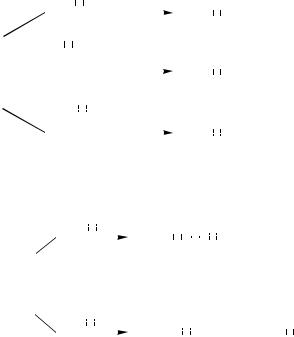
III.2.8.2 PALLADIUM-CATALYZED ALKYNYLATION WITH ALKYNYLMETALS |
533 |
1.Pd(PPh3)4 (1 equiv)
2.LiC CBu-t (1 equiv)
CBu-t (1 equiv)
|
|
|
|
|
|
|
|
|
|
|
|
|
|
|
|
|
|
PhC |
|
|
|
|
|
|
|
CBu-t |
|
|
|
||
|
|
|
|
|
|
|
|
|
|
|
|
|
|
|
|
|
|
|
|
|
|
|
|||||||||
|
|
|
|
|
|
|
|
|
|
|
|
|
|
|
|
|
|
|
|
|
|
|
|||||||||
|
|
|
|
|
|
|
|
|
|
|
|
|
|
|
|
|
|
|
|
|
|
|
|
|
|
||||||
|
|
|
|
|
|
|
|
|
|
|
|
|
|
|
|
|
|
>95% |
|
|
|
||||||||||
|
|
LiC |
|
CBu-t (1 equiv) |
|
|
|
|
|
|
|
|
|
|
|
|
|
|
|||||||||||||
|
|
|
|
|
|
|
|
|
|
|
|
|
|
|
|
|
|||||||||||||||
|
|
|
|
|
|
|
|
|
|
|
|
|
|
|
|
|
|||||||||||||||
|
|
|
|
|
|
|
|
|
|
|
|
|
|
|
|
|
|||||||||||||||
PhI |
|
5 mol % Pd(PPh3)4 |
PhC |
|
|
|
|
|
CBu-t |
+ |
PhI |
||||||||||||||||||||
|
|
|
|
|
|
|
|
|
|
|
|
|
|
|
|
|
|
|
|
|
|||||||||||
|
|
|
|
|
|
|
|
|
|
|
|
|
|
|
|
|
|
|
|
|
|
||||||||||
|
|
|
|
|
|
|
|
|
|
|
|
|
|
|
|
|
|
|
|
|
|
||||||||||
|
|
|
|
|
|
|
|
|
|
|
|
|
|
|
|
|
|
10% |
90% remaining unreacted |
||||||||||||
|
|
ClZnC |
|
CBu-t (1 equiv) |
|
|
|
|
|
|
|
|
|
|
|
|
|
|
|||||||||||||
|
|
|
|
|
|
|
|
|
|
|
|
|
|
|
|
|
|||||||||||||||
|
|
|
|
|
|
|
|
|
|
|
|
|
|
|
|
|
|||||||||||||||
|
|
|
|
|
|
|
|
|
|
|
|
|
|
|
|
|
|||||||||||||||
|
|
5 mol % Pd(PPh3)4 |
PhC |
|
|
|
|
|
|
CBu-t |
|
|
|
||||||||||||||||||
|
|
|
|
|
|
|
|
|
|
|
|
|
|
|
|
|
|
|
|
|
|
|
|
|
|
|
|||||
|
|
|
|
|
|
|
|
|
|
|
|
|
|
|
|
|
|
|
|
|
|
|
|
|
|
||||||
|
|
|
|
|
|
|
|
|
|
|
|
|
|
|
|
|
|
90% |
|
|
|
||||||||||
|
|
|
|
|
|
|
|
|
|
|
|
Scheme 1 |
|
|
|
|
|
|
|
|
|||||||||||
|
|
|
2 LiC |
|
|
CBu-t |
|
|
|
|
|
|
|
|
|
|
|
+ (LiCl)nPd(PPh3)4 |
|||||||||||||
|
|
|
|
|
|
|
|
|
|
|
|
|
|
|
|
||||||||||||||||
|
|
|
|
|
|
|
|
|
|
|
|
|
|
|
|
||||||||||||||||
|
|
|
|
|
|
|
|
|
|
|
|
|
|
|
|
||||||||||||||||
|
|
|
|
|
|
|
|
|
|
|
|
t-BuC |
|
C |
|
C |
|
|
CBu-t |
||||||||||||
|
|
|
|
|
|
|
|
|
|
|
|
|
|
|
|
||||||||||||||||
>95% |
|
|
|
|
|
|
|
|
|
|
(n = 1 or 2) |
||||||||||||||||||||
Cl2Pd(PPh3)2 |
|
|
|
|
|
|
|
|
|
|
|
|
|
|
|||||||||||||||||
|
|
|
8 LiC |
|
CBu-t |
|
|
|
|
|
|
|
|
|
|
|
|
|
CBu-t + 2 PPh3 |
||||||||||||
|
|
|
|
|
|
|
|
|
|
|
|
|
|
|
|
|
|
||||||||||||||
|
|
|
|
|
|
|
|
|
|
|
|
|
|
|
|
|
|||||||||||||||
|
|
|
|
|
|
|
|
|
|
|
|
|
|
|
|
|
|
||||||||||||||
|
|
|
|
|
|
|
|
|
|
|
|
Li2Pd(C |
|
CBu-t)4 + |
4 LiC |
|
|||||||||||||||
|
|
|
|
|
|
|
|
|
|
|
|
|
|
||||||||||||||||||
>95% |
|
|
|
|
|
|
|
|
|
|
|
+ 2 LiCl |
|||||||||||||||||||
Scheme 2
Finally, Hg (Entries 8 and 9), Si (Entry 15), and Zr (Entry 18) appear to be essentially ineffective probably for different reasons. In short, the countercation survey reported in 1978[4] clearly indicated that, besides Cu used in the Sonogashira reaction (Sect. III.2.8.1), Zn, Mg, B, Al, and Sn showed promising results. Those alkynylmetals that contain Zn, B, Al, and Sn are usually generated from alkynylmagnesium derivatives or alkynyllithiums. So, in cases where alkynylmagnesium reagents are very satisfactory, there would be no need for any of the other metals. In reality, however, there are a number of limitations associated with alkynylmagnesium derivatives. In such cases, Zn, B, Al, and Sn may then be considered. In view of the relative ease of generation, low cost, and the highest intrinsic reactivity observed, Zn should be considered first among them. On the other hand, the usefulness of Al appears to be more limited than the other three metals. The lower intrinsic reactivities and significantly higher costs of B and Sn compounds as compared with alkynylzincs would have to be offset by some distinct advantages that B or Sn might offer. The generally high toxicity associated with organotins is another factor in the selection of a suitable countercation. In some cases, however, the high intrinsic reactivity of alkynylzincs has some undesirable effects, and Sn has been shown to be superior to Zn, as discussed later.
Despite the initial promising results observed with alkynylboron derivatives,[4] B had not been used further as the metal component of alkynylmetals until recently.[9]–[11] In view of various factors including intrinsic reactivity and cost, it would be desirable to justify the use of B with some distinct advantages that B might offer.

534 |
III Pd-CATALYZED CROSS-COUPLING |
A.ii. Sonogashira Alkyne Synthesis versus Pd-Catalyzed Alkynylation with Preformed Alkynylmetals
Since Pd-catalyzed alkynylation with preformed alkynylmetals is generally somewhat more involved than the Sonogashira alkynylation, the use of the former protocol has to be duly justified. The following differences between the two protocols are worth noting.
A.ii.a. Synthesis of Terminal Alkynes. The synthesis of terminal alkynes by the Sonogashira reaction using acetylene itself is known not to produce the desired product in satisfactory yields,[1],[2],[6] disubstitution at both ends of acetylene being the major side reaction. Consequently, a three-step alternative involving (i) protection of one end of acetylene, usually in the form of trimethylsilylacetylene, (ii) cross-coupling, and (iii) deprotection is generally employed. On the other hand, the synthesis of terminal alkynes from acetylene without its protection and deprotection was achieved using ethylnylzinc chlorides and bromides as early as 1977.[12] The required ethynylzinc haldies can readily be generated in situ from commercially available HC #CMgX(X Br or Cl). In fact, ethynylmagnesium halides themselves have been shown to be as satisfactory as any other alkynylmetals in many cases.[6] So, it is advisable to consider first the use of HC#CMgX for Pd-catalyzed ethynylation. In cases where they are unsatisfactory, however, ethynylzinc halides should prove to be superior alternatives in most cases, as detailed below. Puzzlingly, ethynylboron derivatives have failed to give the desired terminal alkynes.[6] Some side reactions, such as 1,2-migration, may be suspected.
A.ii.b. Electronic and Steric Impedance in the Sonogashira Alkyne Synthesis. There have been ample indications that terminal alkynes containing electron-withdrawing substituents either fail or are sluggish to undergo the Sonogashira alkynylation. Those that essentially fail to undergo the reaction include F3CC#CH[13] and EtOOCC#CH.[14] A striking difference between the Sonogashira and Negishi protocols is shown in Scheme 3.[13]
Although rigorous comparisons of steric and other electronic effects on the Sonogashira and Negishi alkyne syntheses are essentially unknown, a detailed investigation of the electronic and steric effects for comparing Mg, Zn, and Sn has clearly established that the Zn protocol not only is compatible with both electron-withdrawing and electron-donating substituents but also best tolerates steric hindrance, as detailed below.[6]
|
|
|
|
|
cat. Pd(PPh3)4, Et2NH |
|
F3C |
|||||||||
F3CC |
|
CH + PhI |
|
|
|
F3CC |
|
|
CPh + |
|
NEt2 |
|||||
|
|
|
|
|
|
|
||||||||||
|
|
|
|
|
|
|
||||||||||
|
|
|
1. n-BuLi |
|
|
|
|
0% |
|
|
25% |
|||||
|
|
|
|
|
|
|
||||||||||
|
|
|
|
|
|
|
|
|
|
|
|
|
|
|
||
|
|
|
2. ZnCl2 |
|
|
|
|
|
|
|
|
|
|
|
|
|
|
|
|
|
CZnCl + PhI |
|
cat. Pd(PPh3)4 |
|
|
|
|
||||||
|
|
|
|
|
|
|
|
|
||||||||
F3CC |
|
|
|
|
|
F3CC |
|
|
CPh |
|||||||
|
|
|
|
|
|
|
||||||||||
|
|
|
|
|
|
|||||||||||
|
|
|
|
|
|
|
|
|||||||||
|
|
|
|
|
|
96% |
|
|
|
|
|
|||||
|
|
|
|
|
|
|
|
|
|
|
|
|
|
|
|
|
Scheme 3
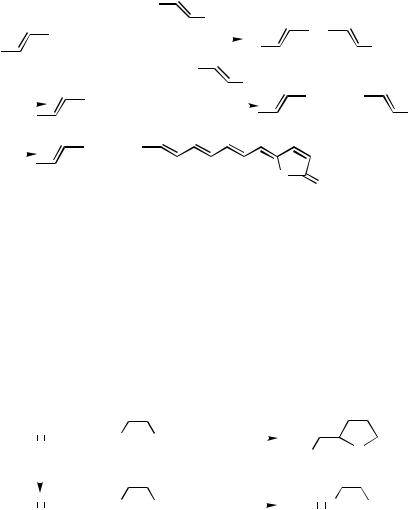
III.2.8.2 PALLADIUM-CATALYZED ALKYNYLATION WITH ALKYNYLMETALS |
535 |
A.ii.c. Other Limitations and Difficulties Associated with the Sonogashira Alkyne Synthesis. Other limitations and difficulties observed with the Sonogashira alkyne synthesis include (i) alkyne dimerization, which appears to be induced by radicals, and (ii) addition of amines to alkynes as exemplified in Scheme 3.[13]
A.ii.d. Comparison of Operational Simplicity. As mentioned earlier, the Sonogashira protocol is operationally somewhat simpler than the use of preformed alkynylmetals. This indeed is the main reason for considering first the Sonogashira protocol in cases where it is very satisfactory. When the starting terminal alkynes are prepared via alkynylmetal intermediates, however, the direct use of alkynylmetals would be more convenient, as demonstrated in a recent synthesis of xerulin[15] (Scheme 4).
|
|
|
|
|
|
|
|
|
|
|
|
I |
|
|
|
|
|
|
|
|
|
|
|
|
|
|
|
|
|
|
|
|
|
|
|
|
|
Br |
|
|
|
|
|
|
|
||
|
|
|
|
|
|
|
ZnBr |
|
|
|
cat. Pd(PPh3)4 |
|
|
|
|
|
|
Br |
|||||
|
|
|
|
|
|
|
|
|
|
|
|
|
|||||||||||
|
|
|
|
|
|
|
|
|
|
|
|
||||||||||||
|
|
|
|
|
|
|
|
|
|
|
|
||||||||||||
|
|
|
|
|
|
|
|
|
|
|
|
|
|
|
|
|
|
|
|
|
|
|
|
1. LDA |
|
|
|
|
I |
|
|
|
|
|
|
|
|||||||||||
|
|
|
|
|
Br |
|
|
|
|
|
|
|
|||||||||||
2. ZnBr2 |
|
|
|
|
|
|
|
|
|
|
|
|
|
|
|||||||||
|
|
|
|
|
ZnBr |
cat. Pd(PPh3)4 |
|
|
|
|
|
|
Br |
||||||||||
|
|
|
|
|
|
|
|
|
|
|
|||||||||||||
|
|
|
|
|
|
|
|
|
|
|
|||||||||||||
|
|
|
|
|
|
|
|
|
|
|
|
|
|
|
|
|
|
|
|
|
|
||
|
|
|
|
|
|
|
|
|
|
|
|
|
|
|
|
|
|
|
|
|
|
|
|
|
steps |
|
|
|
|
|
xerulin |
O |
|||||||||||||||
|
|
|
|
|
|
||||||||||||||||||
|
|
|
|
|
|||||||||||||||||||
|
|
|
|
|
|
|
|
|
|
|
|
|
|||||||||||
|
|
|
|
|
|
|
|
|
|
|
|
|
|||||||||||
|
|
|
|
|
|
|
|
|
|
|
|
|
|
|
O |
||||||||
Scheme 4
A.ii.e. Distinct Reaction Paths for the Sonogashira Reaction and the Negishi Alkyne Synthesis. The Sonogashira and Negishi protocols can follow two distinct reaction paths to give much different products. For example, the reaction of terminal alkynes with (Z )- -iodoacrylic acid under Sonogashira conditions leads to the formation of (Z )--alkylidenebutenolides via a cross-coupling–lactonization tandem process. On the other hand, the corresponding reaction of alkynylzinc bromides provides the crosscoupling products without inducing lactonization[19] (Scheme 5).
|
|
|
|
|
|
|
|
|
cat. PdLn |
|
|
|
|
|
|
|
|
||||
RC |
|
|
|
CH |
+ |
I |
|
COOH |
CuI, NEt3 |
|
|
|
|
|
|
|
O |
||||
|
|
|
|
|
|
|
|
|
|
|
|
|
|
|
|||||||
|
|
|
[15], [16]−[18] |
|
|
|
|
|
|
|
|||||||||||
|
|
|
|
|
|
|
|
|
|
|
O |
||||||||||
|
|
|
1. R1MgBr |
|
|
|
|
R |
|
|
|
|
|
|
|
|
|||||
|
|
|
|
|
|
|
|
|
|
|
|
|
|
|
|
|
|
|
|||
|
|
|
|
2. ZnBr2 |
|
|
|
|
1. cat. PdLn |
|
|
|
|
|
|
|
|
||||
|
|
|
|
|
|
|
|
|
|
|
|
|
|
|
|||||||
RC |
|
|
CZnBr |
+ |
|
|
|
2. H3O+ |
|
|
|
|
|
|
|
|
|||||
|
|
|
|
|
|
|
|
|
|
|
|
|
|||||||||
|
I |
|
COOH |
|
RC |
|
C |
|
|
|
|
COOH |
|||||||||
|
|
|
[19] |
|
|
|
|
|
|
||||||||||||
|
|
|
|
|
|
|
|
|
|
|
|
|
|
|
|
|
|
|
|
|
|
Scheme 5
536 |
III Pd-CATALYZED CROSS-COUPLING |
B. Pd-CATALYZED ALKYNYLATION WITH ALKYNYLMETALS
CONTAINING Mg, Zn, AND Al
B.i. Alkynylaluminums
Alkynylmetals containing Mg, Zn, and Al have been shown to be effective among those containing relatively electropositive metals.[4] However, alkynylaluminum derivatives have rarely been used.[4],[20],[21] Enol phosphates derived from ketones readily react with PhC#CAlEt2 and n-BuC#CAlEt2 in the presence of 1 mol % of Pd(PPh3)4 in 57 – 83% yields.[20],[21] As the use of organoaluminums is somewhat more involved than those containing Mg or even Zn, it should be reserved for those cases in which the use of Al leads to more favorable results than other more convenient options.
B.ii. Synthesis of Terminal Alkynes with Ethynylmetals Containing Mg and Zn
Because of the highest reactivity and the seemingly broadest scope that alkynylzincs display, they have been most extensively investigated and used among preformed alkynylmetals. With respect to ethynylation to produce terminal alkynes, a detailed comparison of Mg, Zn, and Sn was made.[6],[22],[23] The results summarized in Table 2 indicate that all three metals are satisfactory in less demanding cases but that the lower catalytic reactivity of Mg and Sn as well as a significantly higher tendency of Mg to undergo disubstitution are clearly seen in sterically and electronically more demanding cases. Even so, the direct use of commercially available and economical HC#CMgX (X Cl or Br) should be considered, when they are effective, while the use of more expensive and toxic Sn reagents should be reserved for those cases where neither Mg nor Zn is effective for chemoselectivity or other reasons.
B.iii. Scope of Pd-Catalyzed Alkynylation with Alkynylmetals Containing Mg and Zn with Respect to the Alkynyl Groups and Organic Electrophiles
Some additional representative examples of Pd-catalyzed alkynylation with alkynylmetals containing Mg and Zn are summarized in Table 3.[5],[24]–[39] The results indicate that the scope of the reaction with respect to the alkynyl groups is indeed very broad. In addition to the parent ethynyl group (Sect. B.ii.) and electron-withdrawing carbon groups (Scheme 3), a wide variety of other carbon groups including alkyl, alkenyl, aryl, and alkynyl (Scheme 4) groups of various steric and electronic requirements can be accommodated. Heteroatom groups containing Si (Entries 9 –13), N (Entry 14), and O (Entry 15) can also be accommodated.
The scope with respect to organic electrophiles has been largely limited to alkenyl, aryl, and acyl derivatives containing I, Br, OPO(OPh)2,[20],[21] and OSO2CF3.[27] In the cases of acyl derivatives, acyl chlorides have mostly been used.[24] Alkynylation of alkyl electrophiles including allyl, propargyl, and benzyl derivatives is usually better accomplished by some known methods involving Li, Mg, and Cu. Moreover, Pd catalysis appears to be largely ineffective in most of these cases. The Pd-catalyzed reaction of alkynylmetals containing Mg and Zn with alkynyl iodides and bromides proceeds readily but leads to the mixtures of the desired conjugated diynes and the two possible homodimers[40] except in some favorable combinations. For strictly “pair-selective” synthesis of unsymmetrically substituted conjugated diynes by Pd-catalyzed cross-coupling, an alternate approach involving Pd-catalyzed alkynyl – alkenyl coupling with 1,2-dihaloethylene discussed in Sect. III.2.14.2 and later in this section should be considered.
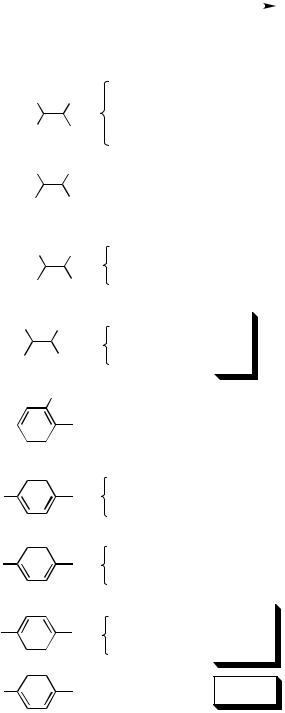
III.2.8.2 PALLADIUM-CATALYZED ALKYNYLATION WITH ALKYNYLMETALS |
537 |
TABLE 2. Comparison of Metal Countercations in the Direct Synthesis of Terminal Alkynes by Pd-Catalyzed Ethynylation with Ethynylmetals Containing Mg, Zn, and Sn
|
|
|
|
|
|
HC#CM |
|
RI |
|
5% Pd(PPh3)4 |
|
HC#CR |
|
|||
|
|
|
|
|
|
|
|
THF |
|
|||||||
|
|
|
|
|
|
|
|
|
|
|
|
|
|
|||
|
|
|
|
|
|
|
|
|
|
|
|
|
|
|
||
|
|
|
|
|
|
|
|
Time b |
|
Product Yield c (%) |
Residual |
|
||||
RI |
|
|
|
Ma |
(h) |
HC#CR |
RC#CR |
RIc (%) |
Reference |
|||||||
|
|
|
|
|
|
|
|
|
|
|
|
|
|
|
|
|
n-Hex |
|
|
H |
MgBr |
1 |
95 |
|
|
d |
d |
|
|||||
|
|
|
|
|
|
|
|
|
|
|
|
|||||
|
H |
|
|
I |
ZnBr |
1 |
96 |
|
|
d |
d |
[6] |
||||
|
|
|
|
|
||||||||||||
|
|
|
SnBu3 |
|
|
|
|
|
|
|
|
|
||||
|
|
|
|
|
|
|
6 |
|
95 |
|
|
d |
d |
|
||
|
H |
|
|
H |
|
|
|
|
|
|
|
|
|
|
||
|
|
|
|
|
|
|
ZnCl |
d |
83 (65) |
|
d |
d |
[12] |
|||
n-Bu |
|
|
I |
|||||||||||||
|
|
|
|
|
|
|
|
|
|
|
|
|||||
n-Hex |
|
|
H |
MgBr |
1 |
94 |
|
|
d |
d |
|
|||||
Me |
|
|
I |
ZnBr |
1 |
94 |
|
|
d |
d |
[6] |
|||||
|
|
|
|
|||||||||||||
|
|
|
|
|
||||||||||||
|
|
|
|
|
|
|
|
|
|
|
|
|
||||
n-Pr |
|
|
Pr-n |
MgBr |
24e |
|
82 |
|
|
d |
d |
[6] |
||||
Me |
|
I |
ZnBr |
3e |
|
95 |
|
|
d |
d |
||||||
|
|
|
|
|
||||||||||||
|
|
|
|
|
Me |
|
|
|
|
|
|
|
|
|
|
|
|
|
|
|
|
|
I |
ZnCl |
3 |
71 |
|
|
d |
d |
[22] |
||
|
|
|
|
|
|
|
|
|
|
|
|
|
|
|
|
|
|
|
|
|
|
|
|
MgBr |
1 |
95 |
|
|
d |
0 |
|
||
|
|
|
|
|
|
|
|
|
|
|||||||
MeO |
|
|
I |
[6] |
||||||||||||
|
|
|
|
|
|
|
|
|
|
|
||||||
|
|
|
|
|
|
|
ZnBr |
1 |
95 |
|
|
d |
0 |
|
||
|
|
|
|
|
|
|
MgBr |
1 |
97 (72) |
|
d |
0 |
[6] |
|||
F |
|
|
I |
|||||||||||||
|
|
|
|
|
|
|
|
|
|
|
||||||
|
|
|
|
|
|
|
ZnBr |
1 |
94 |
|
|
d |
0 |
|
||
|
|
|
|
|
|
|
MgBr |
|
|
|
|
|
|
d |
d |
|
|
|
|
|
|
|
|
12 |
|
0 |
|
|
[6] |
||||
ON2 |
|
|
I |
|
|
|
|
|
|
|
|
|
||||
|
|
|
|
|
|
|
|
|
|
|
|
|||||
|
|
|
|
|
|
|
ZnBr |
3 |
|
93 (89) |
|
d |
0 |
|
||
|
|
|
|
|
|
|
|
|
|
|||||||
|
|
|
|
|
|
|
ZnBr |
|
|
92 (86) |
|
|
|
[6] |
||
MeOOC |
|
|
I |
1 |
|
d |
0 |
|||||||||
(Continued )
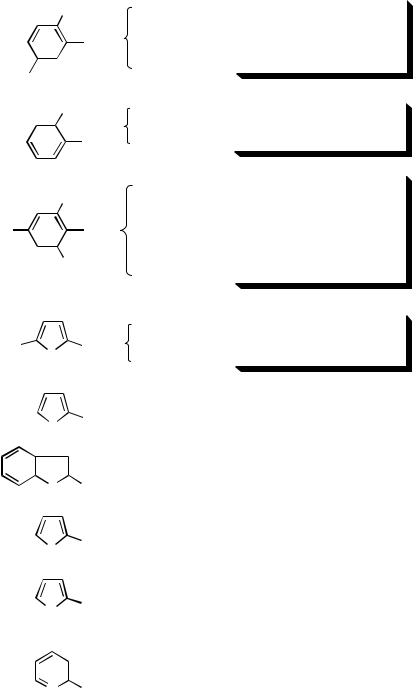
538 |
III Pd-CATALYZED CROSS-COUPLING |
|
|
|
|
|
|||||||
TABLE 2. (Continued ) |
|
|
|
|
|
|
|
||||||
|
|
|
|
|
|
|
|
|
|
|
|
|
|
|
|
|
|
|
|
|
|
Time b |
|
Product Yield c (%) |
Residual |
|
|
|
|
RI |
|
|
Ma |
(h) |
HC#CR |
RC#CR |
RIc (%) |
Reference |
|||
|
|
|
|
|
Me |
MgBr |
|
|
|
|
|
|
|
|
|
|
|
|
48 |
|
60 (56) |
24 |
14 |
|
|||
|
|
|
|
|
|
I |
ZnBr |
3 |
|
92 (85) |
4 |
0 |
[6] |
|
|
|
|
|
|
|
|
|
|
|
|
|
|
|
|
|
|
|
|
|
SnBu3 |
24 |
|
73 |
6 |
15 |
|
|
Me |
|
|
|
|
||||||||
|
OMe |
MgBr |
|
|
|
|
|
|
|||||
|
|
|
|
|
|
|
|||||||
|
|
|
|
|
|
|
|
|
|
|
|||
|
|
|
|
|
20 |
|
51 |
36 |
d |
|
|||
|
|
|
|
|
|
I |
ZnBr |
2 |
|
77 |
Trace |
d |
[6] |
|
|
|
|
|
|
|
|||||||
|
|
|
|
|
|
|
|
||||||
|
|
|
|
|
|
|
MgBr |
48f |
|
|
|
|
|
|
|
|
|
|
|
|
|
|
|
|
|
||
|
|
|
|
|
Me |
|
28 |
12 |
66 |
|
|||
|
|
|
|
|
|
|
|
|
|
|
|
||
Me |
|
|
|
|
|
I |
MgBr |
24g |
|
1 |
d |
95 |
[6] |
|
|
|
|
|
|
18g |
|
|
|
|
|||
|
|
|
|
|
Me |
ZnBr |
|
74 (68) |
10 |
d |
|
||
|
|
|
|
|
|
||||||||
|
|
|
|
|
SnBu3 |
72g |
|
36 |
8 |
52 |
|
||
|
|
|
|
|
|
|
|
|
|||||
|
|
|
|
|
|
|
MgBr |
|
|
|
|
|
|
|
|
|
|
|
|
|
d |
|
35 |
24 |
d |
[23] |
|
Me |
|
I |
|
|
|
|
|
|
|||||
|
|
|
|
|
|
|
|
||||||
|
|
|
S |
|
|
ZnBr |
d |
|
87 |
0 |
0 |
|
|
|
|
|
|
|
|
|
|
|
|
|
|
|
|
|
|
|
S |
|
I |
ZnBr |
1 |
85 (71) |
d |
d |
[23] |
||
|
|
|
|
|
|
|
|
|
|
|
|
||
|
|
|
S |
|
I |
ZnBr |
1 |
92 (71) |
d |
d |
[23] |
||
|
|
|
|
||||||||||
|
|
|
|
||||||||||
|
|
|
|
|
|
|
|
|
|
|
|||
|
|
|
O |
|
I |
ZnBr |
1 |
92 |
d |
d |
[23] |
||
|
|
|
|
|
|
|
|
|
|
|
|
||
|
|
|
N |
|
I |
ZnBr |
4 |
76 |
d |
d |
[23] |
||
|
|
|
Me |
|
|
|
|
|
|
|
|
|
|
|
|
|
N |
|
I |
ZnBr |
5g |
70 |
<2 |
d |
[23] |
||
|
|
|
|
||||||||||
|
|
|
|
||||||||||
|
|
|
|
|
|
|
|
|
|
|
|||

III.2.8.2 PALLADIUM-CATALYZED ALKYNYLATION WITH ALKYNYLMETALS |
539 |
|||||||||
TABLE 2. (Continued ) |
|
|
|
|
|
|
|
|||
|
|
|
|
|
|
|
|
|
|
|
|
|
|
|
Time b |
|
Product Yield c (%) |
Residual |
|
|
|
RI |
|
Ma |
(h) |
HC#CR |
RC#CR |
RIc (%) |
Reference |
|||
|
|
|
ZnBr |
24g |
21 |
44 |
d |
|
[23] |
|
|
|
|
|
|||||||
|
|
|
||||||||
N |
Br |
|
|
|
|
|
|
|
||
|
|
N |
24g |
|
|
|
|
|
|
|
|
|
|
ZnBr |
62 (58) |
24 |
d |
|
[23] |
||
|
|
|
|
|||||||
Br
aHC#CZnBr and HC#CSnBu3 were generated in situ from the treatment of HC#CMgBr with ZnBr2 and ClSnBu3, respectively. HC#CZnCl was generated by the treatment of HC#CLi with ZnCl2.
bUnless otherwise mentioned, the reaction temperature was 22 C.
cGLC or NMR yield. The numbers in parentheses are isolated yields.
dNot observed or detected.
eAt 50 C in DMF.
fAt 60 C in DMF.
gAt 50 –60 C in THF-DMF.
The effects of the structure and substituents of alkenyl and aryl groups have been delineated,[6],[12],[22],[23] and some results are summarized in Table 2 in the context of ethynylation. In addition, the results shown in Table 3 indicate that alkenyl halides containing a wide variety of heteroatom substituents, such as -silyl (Entry 6) and -halo substituents (Entries 5, 7, 9, 10, and 14) (Sect. III.2.14.2), fluorinated alkenyl (Entry 3), and -oxy-substituted alkenyl, can be accommodated.
B.iv. Pd-Catalyzed Alkynyl – Alkenyl Coupling Route to Conjugated Diynes as a Strictly “Pair-Selective” Alternative to the Cadiot – Chodkiewicz Reaction
The Pd-catalyzed reaction of (E )-3-penten-1-ynylzinc bromide with (E )-bromoiodoethene followed by treatment with LDA shown in Scheme 4[15] provides a selective and convenient route to the desired terminal diyne, which can be further converted to unsymmetrically substituted conjugated diynes. This and its modifications with (E )-chloroiodoethene provide synthetic equivalents or alternatives to the Cadiot – Chodkiewicz reaction.[41] As shown in Scheme 6, both the Cadiot – Chodkiewicz protocol and the Negishi coupling protocol[42] require three steps from one terminal alkyne, one ethyne, and a suitable electrophile, such as organic halides. In the former, the second terminal alkyne may be prepared either from ethyne and a suitable electrophile or by its alternative. One of the two alkynes must then be converted to the corresponding 1-bromo- or 1-iodoalkyne prior to the crucial Cu-catalyzed cross-coupling. In the latter protocol, ethyne is converted first to either bromoiodoethene or chloroiodoethene. This is then cross-coupled with an alkylnylmetal containing Zn, Mg, or another suitable metal generated in situ. In the third step, the haloenyne prepared above is treated with a base to produce the corresponding 1-metallo- 1,3-diyne, which can then be converted to variously substituted conjugated diynes (Scheme 6). Some representative results are summarized in Scheme 7.
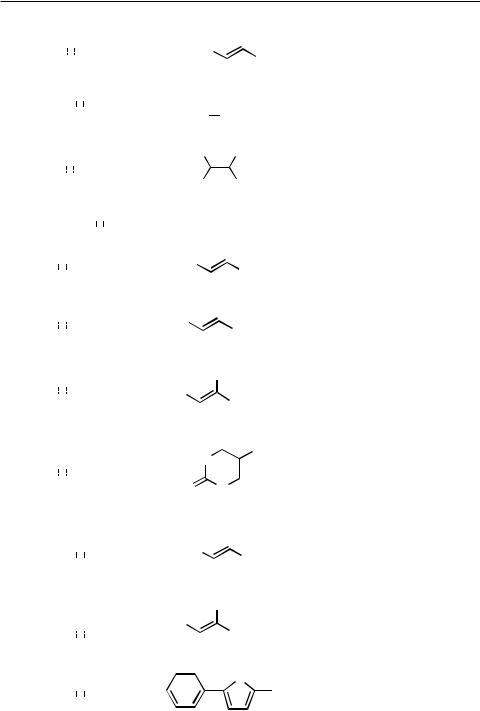
540 |
III Pd-CATALYZED CROSS-COUPLING |
TABLE 3. Pd-Catalyzed Cross-Coupling of Aryl and Alkenyl Electrophiles with Alkynylmetals Containing Mg and Zn
|
|
|
|
|
|
Aryl, Alkenyl, or Acyl |
|
Product |
|
||
Entry |
Alkynylmetal |
Electrophile a |
Pd Catalyst b |
Yield (%) |
Reference |
||||||
1 |
H3CC |
|
CMgCl |
C6H13 |
A |
83 |
[5] |
||||
|
|||||||||||
|
|||||||||||
|
|||||||||||
|
|
|
|
|
|
|
|
I |
|
|
|
2 |
C5H11C |
|
CZnCl |
O |
A |
81 |
[24] |
||||
|
|
|
|
||||||||
|
|
|
|
||||||||
Me C Cl
Cl
I F
3 |
HexC |
|
|
CZnCl |
|
|
|
F |
|
|
|
|
|
|
F |
|
A |
62 |
[25],[26] |
|||||||
|
|
|
|
|
|
|
|
|
|
|
|
|||||||||||||||
|
|
|
|
|
|
|
|
|
|
|
|
|||||||||||||||
|
|
|
|
|
|
|
|
|
|
|
|
|||||||||||||||
|
|
|
|
|
|
|
|
|
|
|
|
|
|
|
|
|
|
|
|
|
|
|
|
|
||
4 |
H COH |
CC |
|
CZnCl |
|
Ph |
|
OSO2CF3 |
|
A |
67 |
[27] |
||||||||||||||
|
|
|
|
|||||||||||||||||||||||
|
|
|
|
|||||||||||||||||||||||
3 |
|
2 |
|
|
|
|
|
|
|
|
|
|
|
|
|
|
|
|
|
|||||||
5 |
PhC |
|
|
CZnCl |
|
Br |
|
|
|
|
|
|
Br |
|
A |
42 |
[28],[29] |
|||||||||
|
|
|
|
|
|
|
|
|
|
|||||||||||||||||
|
|
|
|
|
|
|
|
|
|
|||||||||||||||||
|
|
|
|
|
|
|
|
|
|
|
|
|
||||||||||||||
|
|
|
|
|
|
|
|
|
|
|
|
|
|
|
|
|
|
|
|
|
|
|
|
|
|
|
6 |
PhC |
|
|
CZnCl |
Br |
|
|
|
|
SiMe3 |
|
A |
88 |
[30],[31] |
||||||||||||
|
|
|
|
|
|
|
||||||||||||||||||||
|
|
|
|
|
|
|
||||||||||||||||||||
|
|
|
|
|
|
|
|
|
|
|
||||||||||||||||
|
|
|
|
|
|
|
|
|
|
|
|
|
|
|
|
|
|
|
|
|
|
|
|
|||
|
|
|
|
|
|
|
|
|
|
|
|
|
|
|
|
|
Br |
|
|
|
|
|||||
7 |
PhC |
|
|
CZnCl |
Br |
|
|
|
|
COOEt |
|
A |
64 |
[32] |
||||||||||||
|
|
|
|
|
|
|
||||||||||||||||||||
|
|
|
|
|
|
|
||||||||||||||||||||
|
|
|
|
|
|
|
||||||||||||||||||||
|
|
|
|
|
|
|
|
|
|
|
|
|
|
|
|
|
|
|
|
|
|
|
|
|||
|
|
|
|
|
|
|
|
|
|
|
|
|
|
|
|
|
O |
|
|
|
|
|||||
|
|
|
|
|
|
|
|
|
|
|
|
|
|
|
|
|
|
|
|
|
|
I |
|
|
|
|
8 |
PhC |
|
|
CZnCl |
|
|
NH |
|
|
B |
95 |
[33] |
||||||||||||||
|
|
|
|
|
|
|
||||||||||||||||||||
|
|
|
|
|||||||||||||||||||||||
|
|
|
O |
|
|
|
|
|
|
|
|
|||||||||||||||
|
|
|
|
|
|
|
|
|
|
|
||||||||||||||||
|
|
|
|
|
|
|
|
|
|
|
||||||||||||||||
|
|
|
|
|
|
|
|
|
|
|
||||||||||||||||
|
|
|
|
|
|
|
|
|
|
|
|
|
|
N |
|
|
|
|
||||||||
|
|
|
|
|
|
|
|
|
|
|
|
|
TMSdR |
|
|
|
|
|
|
|||||||
|
|
|
|
|
|
|
|
|
|
|
|
|
|
|
|
|
||||||||||
9 |
Me3SiC |
|
|
|
CZnCl |
|
Bu |
|
|
|
|
|
|
Br |
|
A |
77 |
[34] |
||||||||
|
|
|
|
|
|
|
|
|
|
|
||||||||||||||||
|
|
|
|
|
|
|
|
|
|
|
|
|
|
|||||||||||||
|
|
|
|
|
|
|
|
|
|
|
|
|
|
|||||||||||||
|
|
|
|
|
|
|
|
|
|
|
|
|
|
|
|
|
Br |
|
|
|
|
|||||
10 |
Me3SiC |
|
|
|
CZnCl |
Br |
|
|
|
|
COOEt |
|
A |
91 |
[35] |
|||||||||||
|
|
|
|
|
|
|
|
|
|
|
|
|||||||||||||||
|
|
|
|
|
|
|
|
|
|
|
|
|||||||||||||||
|
|
|
|
|
|
|
|
|
|
|
|
|||||||||||||||
|
|
|
|
|
|
|
|
|
|
|
|
|||||||||||||||
|
|
|
|
|
|
|
|
|
|
|
|
|
|
|
|
|
|
|
|
|
|
S |
I |
|
|
|
|
|
|
|
|
|
|
|
|
|
|
|
|
|
|
|
|
|
|
|
|
|
|
|
|
||
|
|
|
|
|
|
|
|
|
|
|
|
|
|
|
|
|
|
|
|
|
|
|
|
|
|
|
|
|
|
|
|
|
|
|
|
|
|
|
|
|
|
|
|
|
|
|
|
|
|
|
|
|
|
11 |
Me3SiC |
|
|
CMgBr |
|
|
|
|
|
|
|
|
|
|
|
A |
89 |
[36] |
||||||||
|
|
|
|
|
|
|
|
|
|
|
|
|
|
|||||||||||||
